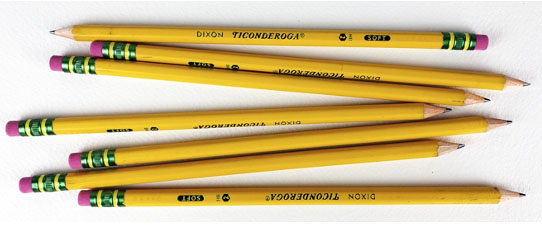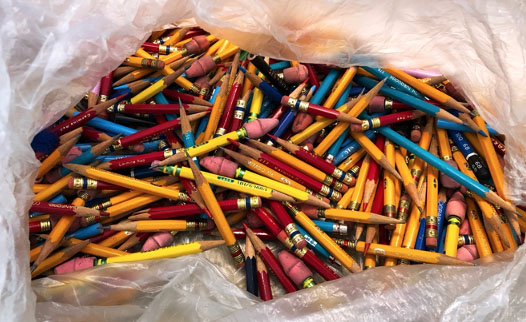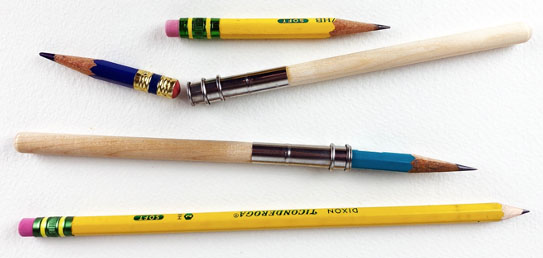

The Dixon Ticonderoga Yellow No. 2 pencils is my pencil of choice and I’ve been using it since at least kindergarten.
There are not many things that any of us can say we have used for most of our lives outside of the necessities. Okay, sure you can say that you have worn blue-jeans since you were a tike, or you have had numerous pairs of suede desert boots. I have. But I am talking about a simple pencil that I started using in kindergarten, maybe even before that, and have used consistently throughout my formative grade school years, Jr. high school, and Sr. high school where I took the SATs, then into college and throughout my animation career at Walt Disney Feature Animation.
For more than a half century, I have had a Yellow No.2 pencil within arm’s reach, most of the time. Whether at home or at work, I always had a stack of these bright yellow hexagonal pencils adorned with the metal ferrule holding a latex-free pink eraser. It has been my pencil of choice throughout my entire four-decade animation career. I rarely strayed from it and the hardness of that graphite core.

Yes, that is me at my Weber animation desk using a Yellow No.2 pencil on some animation drawings, circa 2003 or so, for a special project at Walt Disney Animation Studios.
Many animation professionals today use a stylus with a tablet and specialty animation software loaded on computer hardware. Some have only created animation on such a system, which is a shame. They have missed out on hand-drawn animation and the beauty that fluid lines bring to the medium. Traditional pencil animation is a technique unto itself just as any technique yields unique results.
The pencil can be traced back to the ancient Roman Empire writing implement called a stylus— not be confused with the modern digital stylus. No, the Roman stylus was a thin metal rod that left a light yet readable mark on papyrus, a form of paper. Some early styluses were made of lead, which is what many still refer to pencil cores as today even though they are made of non-toxic graphite.(1)
Graphite came into widespread use after a large deposit was discovered in Borrowdale, England in 1564. There are several qualities in graphite that set it apart from lead. First, it is much darker when leaving a mark on paper and it is non-toxic when processed. Second, it is softer therefore it required some kind of holder. After trying to wrap graphite sticks in string, it was later inserted into hollowed-out wooden sticks giving way to the birth of the modern pencil.(2)
But the pencil was not mass produced for nearly one-hundred years until 1662 in Nuremburg, Germany. Companies with familiar names like Faber-Castell, Steadtler and Lyra became the driving force as the pencil industry developed in conjunction with the 19th century industrial revolution.(3) By the 1890s many of the German companies established factories in the New York and New Jersey area including Faber-Castell, Eberhard Faber, Eagle Pencil Company (later Berol) and General Pencil Company.
Joseph Dixon, an entrepreneur and the son of ship captain, began experimenting with graphite he found on his father’s ship in 1812. Dixon mixed graphite power, clay and water then rolled it into strips that he baked in his mother’s oven. He took the baked mixer and pressed into “grooved cedar wood” producing his first pencil.(4)
![]() It wasn’t until the Civil War that the pencil gained traction as an everyday writing instrument. Soldiers wanted a more practical alternative to using a quill or dip pen for writing letters home. From that point on the pencil became widely adapted. To keep up with the demand, Dixon developed a machine that could produce more than 130 pencils a minute and with innovations in machinery the output climbed to 86,000 pencils a day by 1872.(5)
It wasn’t until the Civil War that the pencil gained traction as an everyday writing instrument. Soldiers wanted a more practical alternative to using a quill or dip pen for writing letters home. From that point on the pencil became widely adapted. To keep up with the demand, Dixon developed a machine that could produce more than 130 pencils a minute and with innovations in machinery the output climbed to 86,000 pencils a day by 1872.(5)
The hexagonal shape of the pencil was designed that way to get an extra pencil out of the standard width wood slats used in pencil making. The wood slats are milled in two sections with long grooves for the graphite. Once the graphite is laid into the groove of the bottom slat, the top slat is glued on and then cut apart producing the individual pencils. The pencils are then painted, embossed with the brand information, and the ferrule and eraser are added.
Pencils were initially unpainted to show of the beauty of the wood, usually cedar. But in the late 1800s, pencils started to get painted. Yellow became the color most associated with pencils that used the finest and most superior graphite, which at the time was produced by China. (6)
There is a difference in the graphite used in pencils and the consistency of how the pencil performs. That consistency has a direct connection to the quality of the graphite and the formula used in creating the graphite rods in the wood casing. Inferior quality graphite lacks strength and therefore breaks more easily with your normal hand pressure while writing or drawing. We have all experienced a pencil tip constantly breaking with the slightest pressure. Whereas superior quality graphite does not chip or shatter and will maintain a point longer especially if you are in the habit of twirling your pencils as it is used. That is my experience.
Quality graphite in the pencils made the difference for me while I worked at Walt Disney Feature Animation. It cut down on the number of times I had to sharpen my Dixon Ticonderoga Yellow No.2 pencil because the point on the graphite lasted longer. This made a difference over the course of a day or week and allowed me to slip into the “zone” while drawing and stay there longer. The zone is simply being fully immersed or absorbed in something, usually creative, to the point that you lose all sense of time. It is a wonderful place to experience, which I do almost daily.
Every artist I know works differently and has their own drawing implements that they like and feel comfortable with using. There is no one way of creating artwork. My use of the Dixon Ticonderoga Yellow No.2 pencil since kindergarten and through my entire animation career has been comfortable and familiar for me and has yielded great results evidenced by the films that I contributed my talents to over the years. To each their own.

The remnants of pencils that I saved in the lower drawer of my Kem Weber animation desk.
During my tenure at Disney Animation, I used my pencils economically often wearing the pencil down to a mere one and half inches long or smaller. I sometimes would use a pencil extender to get the most out of the pencil but often I just held it with my thumb in the crook of my index finger while drawing. It gave me a sense of my finger being the pencil—we were one with the animation. When I could no longer sharpen the nub of a pencil, I would toss it in the lower drawer of my Kem Weber compact animation desk.
Yes, I saved all the used pencil remnants from The Black Cauldron (1985) onward through Fantasia/2000 (2000) and beyond. When you consider that a typical pencil will yield up to 45,000 words(7), can you imagine how many drawings can be created with that same pencil. Even with that knowledge, I went through dozens and dozens of pencils on films like Who Framed Roger Rabbit (1988), The Little Mermaid (1989), Beauty and the Beast (1991), Aladdin (1992), and many others. As each pencil came to the end of its useful life, it was laid to rest in the cool darkness of my desk draw where its animation service was honored but not forgotten.
Rolling that yellow wooden pencil between my thumb, index and middle finger is a tactile experience engrained in my senses. Sitting in the stillness and quiet of my office, I can hear the graphite singing across the toothy surface of the animation bond paper that I’m drawing on—creating an image that likely represents just 1/24th of second. There is pleasure seeing the graphite, guided by my hand, leaving a line that I can vary in density and thickness just by the amount of pressure applied while drawing. Topping it all off is the hint of cedar that you can smell from a freshly sharpened pencil. Using a wooden pencil is truly a sensory experience.

Some of my used pencils compared to a new one and also showing the pencil extenders that I have used from time to time.
There are many kinds of pencils, and everyone has their own favorite. The Dixon Ticonderoga Yellow No.2 pencil is mine, but it wasn’t the only pencil I ever used. I often used carmen red and light blue Col-erase pencils for roughing out a drawing before putting the graphite line down on the paper. I also tried other brands if the supply room was out of my pencils, which happened from time to time.
I used Berol Mirado #174, the “Chem-Sealed” Berol Turquoise, Faber Castell and other pencils in varying hardness’s including soft, hard, B, HB, 2B, 4B, and even 6B, which I jokingly referred to as “liquid lead” because it was so soft. But I always managed to come back to the trusty Dixon Ticonderoga Yellow No.2 pencil, which was perfect for most drawings. Some things never get old.
Those pencils hold fond memories of all the Disney animated films that had the honor and pleasure of working on with my artist colleagues over the decades. I recently moved all the pencils out of the Kem Weber desk drawer and enshrined them in mason jars for display in my office. It seemed like it was time to bring these fallen animation warriors back into the light for no other reason than to spark the many memories they hold. No, I’m not cra-cra, just sentimental on occasion.

These mason jars now contain the pencils that I used on the Disney animated films The Black Cauldron through Fantasia/2000 and beyond. Note the Dixon Ticonderoga Yellow No. 2 pencils with the green and yellow ferrules.
When you think of the renaissance of Disney Animation in the late 1980s through the 1990s and into the early part of the 21st century, just remember that most of that work could not have been accomplished without some type of pencil. It was all those pencil drawings—story sketches, rough animation, clean-up, layouts, effects animation, mark up and checking notes— that were transferred to cels and painted or later scanned into digital space in the CAPS system. Many of the most iconic animated films from that period were, at their core, created with pencils.
Que the music… Memories, Light the corners of my mind; Misty watercolor memories, Of the way we were.(8) Pure schmaltz.
I may not use the Dixon Ticonderoga Yellow No.2 pencils as much as I used to, but I still use them. Almost daily, as I work at my Weber desk, I do reach for one to write a note or to do a quick sketch of an idea. On autopilot, I still jam the pencil into the electric sharpener to bring the graphite point back as I am drawing or writing. Old habits never die.
©2022 David Bossert
Footnotes
1. The History of the Pencil, Pencil History: The Earliest Forms of Self Expression, Pencils.com
2. Ibid
3. Ibid
4. Ticonderoga, Tracing Our Roots, Birth of the Dixon Pencil; weareticonderoga.com
5. Ibid, Demand Fuels Innovation, 1866.
6. Dante A. Ciampaglia, (Mostly) Everything You Always Wanted to Know About Pencils, elective.collegeboard.org
7. Ticonderoga, Tracing Our Roots, What will you do with 45,000 words? weareticonderoga.com
8. Songwriters: Bergman Alan / Bergman Marilyn / Hamlisch Marvin, The Way We Were lyrics © Arlovol Music,
Colgems-emi Music Inc.